Permaculture writer Jonathon Engels shows how duck ponds can benefit both your water-loving fowl and the surrounding ecosystem.
In permaculture design, we are constantly in search of ways to make things function on multiple levels. We like to have waste streams—gray water, kitchen scraps, spoiled animal bedding—cycle productively through our holistic systems, providing solutions rather than creating problems. The ultimate ambition is that everything we put on a homestead or in a backyard, from a tree to a patio to a chicken coop/greenhouse, realizes its potential to cooperate fruitfully with other elements there. Duck ponds are no different.
Stacking Functions
For example, the article “Permaculture and Chickens: Get More Function from Your Fowl” explains stacking functions via how chickens can fulfill many roles beyond meat and egg production. They can help with compost, pest control, weeding, and even fueling a house. It’s up to us, as designers, the purveyors of our plots, to utilize this potential. If we recognize that our garden beds need to be cleared of weed seeds and ground-dwelling pests, and that chickens will lightly till and fertilize the soil in search of these things, and that the protein-rich diet of seeds and bugs for the chicken produces better eggs, we can schedule our chickens for garden clean-up in the fall and garden prep in the spring. It’s free labor and fertilizer from the birds and free feed from the garden. That’s stacking functions.
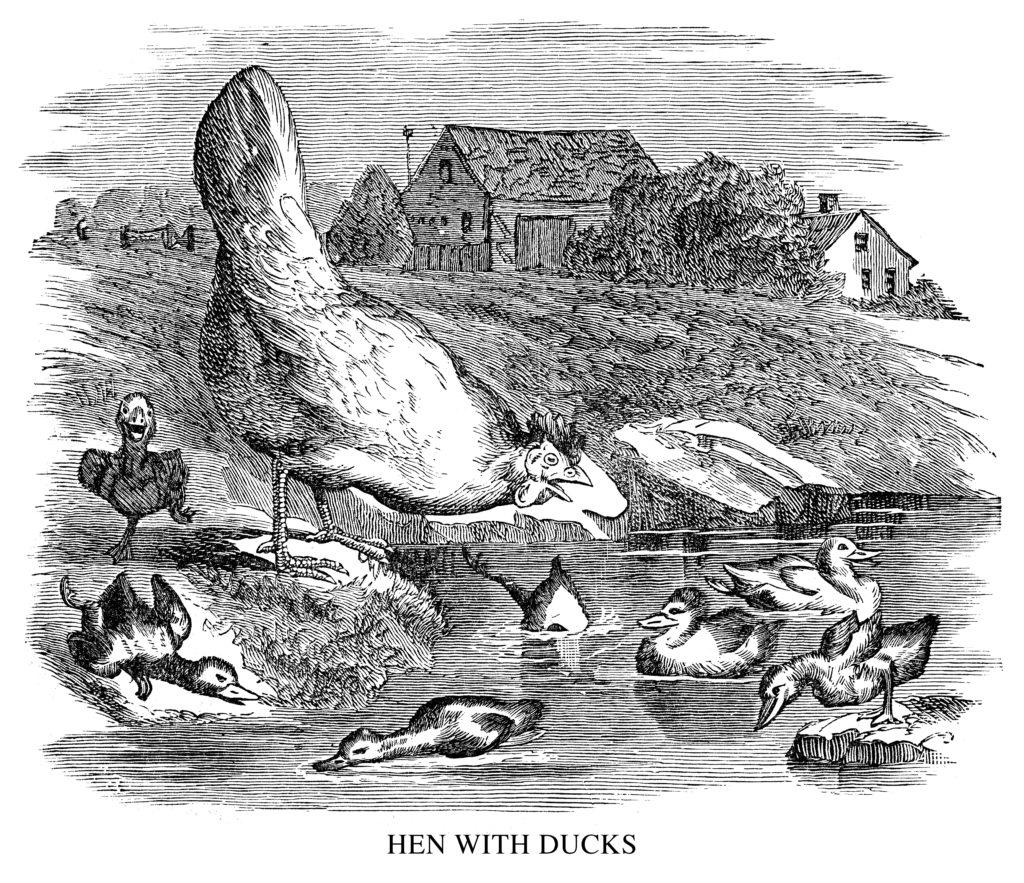
1897 engraving. (Getty images.)
Assessing a Duck Pond
Ponds are to ducks what dust baths are to chickens: necessary for feather preening, parasite prevention, and simple pleasure. The unfortunate part of a duck pond is that the ducks don’t hesitate to poop where they preen. The water quickly gets fouled and thus requires frequent changing, or it will become an unhealthy place for the ducks. Good design requires that we ask ourselves what else could we use the pond for and how we can do something useful with the waste water it produces.
Naturally, there are many productive ways to use a little pond, especially one with plenty of duck manure.
Irrigation, aka Fertigation
Duck ponds are ideal for irrigation, or “fertigation”. Fertigation combines both the standard delivery of water we find in irrigation with the bonus of fertility. A duck pond full of water and duck manure is exactly the right blend for fertigating. We can create a draining system that puts manured water into garden beds to feed plants or into contour swales (water harvesting trenches) to feed trees, and it’ll work like manure tea for the garden while cleaning out the duck pond. We can use the muck from the bottom of the pond for garden beds or compost piles.
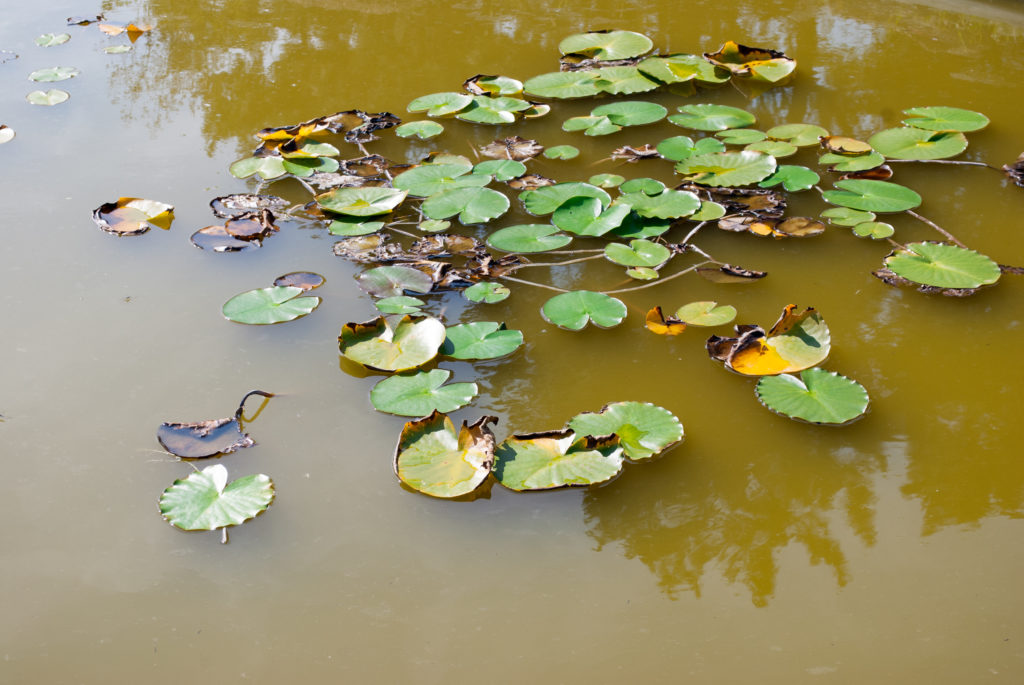
Duck soup.
Fish Cultivation and Biofilters
With ponds that are a half-acre or larger, you can also raise edible fish such as carp or catfish. Because they are typically bottom feeders, these fish will consume duck manure and help filter the water. Non-edible fish like the western mosquitofish (Gambusia affinis) can also cohabitate with your ducks and help reduce the bug population that will naturally use your pond.
These larger ponds (often already established on many farmsteads) tend to maintain themselves. Smaller ponds typically need some help. If you don’t want to constantly be draining your duck pond, you might want to investigate using a cyclical biofilter system that includes a separate reedbed and fish pond. There is an initial outlay of about $2000 to set up this kind of pond, but once established, they function with pretty minimal maintenance.
Edible/Useful Water Plants
If you decide that you are fine with routinely draining your pond, or cycling the water, you still might want to consider adding plants that both you and the ducks will enjoy eating. You fence off certain areas to limit duck access, and cultivate edible plants such as duckweed, lotus, and watercress. Other plants can help a great deal with absorbing nitrogen loads (duck manure) the birds leave in the water. Reeds and sedges (also edible) would clean the water and help to stabilize the banks of the pond, and willow, cherry, elderberry, and bamboo are all productive possibilities for growing near the pond.
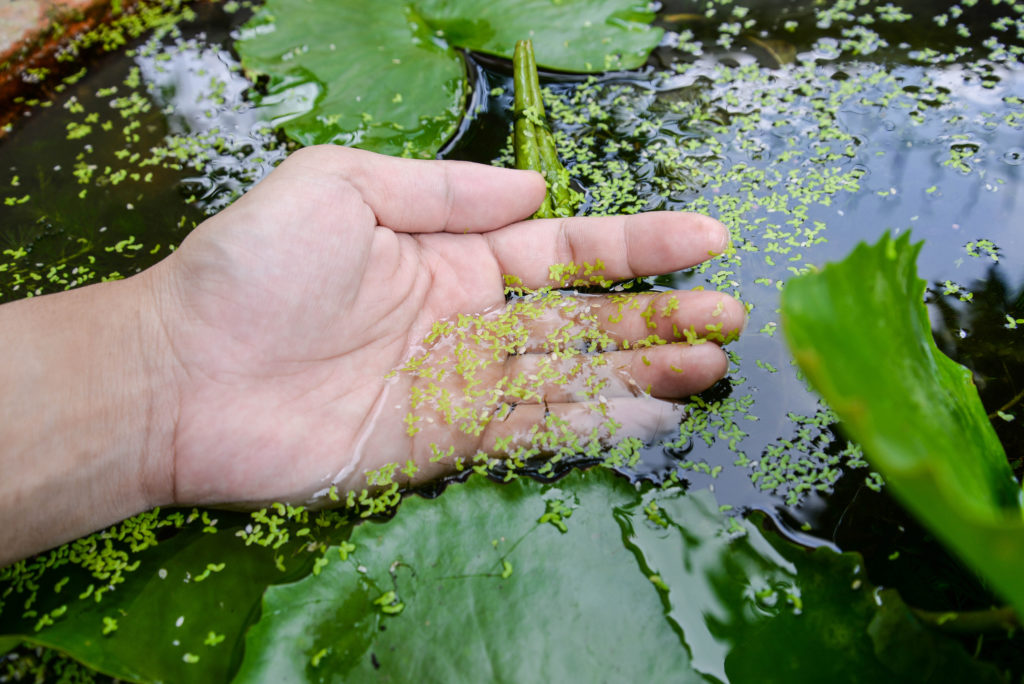
Duckweed.
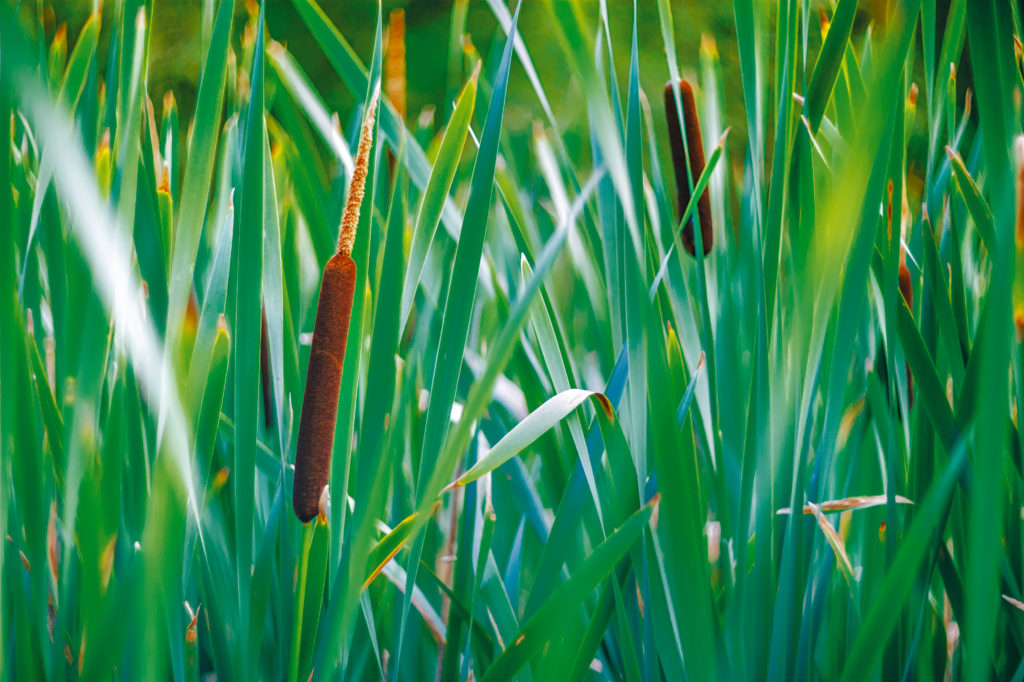
Reeds
Wildlife Habitat
While the main point of building a duck pond is that ducks have a place to frolic, the fact of building such a water feature is that, where the ducks will swim, wildlife will visit them. A duck pond will bring a host of beneficial wildlife to the yard. Frogs and toads will sing happily as they gobble up mosquitoes and pests. Dragonflies, bees, butterflies, and birds will put on aerial shows as they come in for a drink and snack. Small fish will undoubtedly find a way into the scene, also helping to control mosquitoes. Herons will be attracted by the frogs and toads. To make the most of this wildlife refuge, it’s a good idea to include some rockeries, shallows, and plant-life for the animals to enjoy. In turn, they’ll provide entertainment, pest control services, music, pollination, biodiversity, and much more.
Ducks as Pest Control
With the introduction of ducks and the accompanying wildlife in the pond, pest problems and mosquitoes will lessen. All of these animals feed on larvae, bugs, and other problematic guests. While many people fear that adding ducks to the backyard or garden would invite problems, they would actually help eliminate pests, particularly in the garden. Bill Mollison, the founder of permaculture, famously said in response to a question about controlling slugs in the garden: “You don’t have slug problem, you have a duck deficiency.” Ducks will eradicate slugs and snails in well-established gardens, and unlike chickens, if they are monitored, they’ll leave the plants alone.
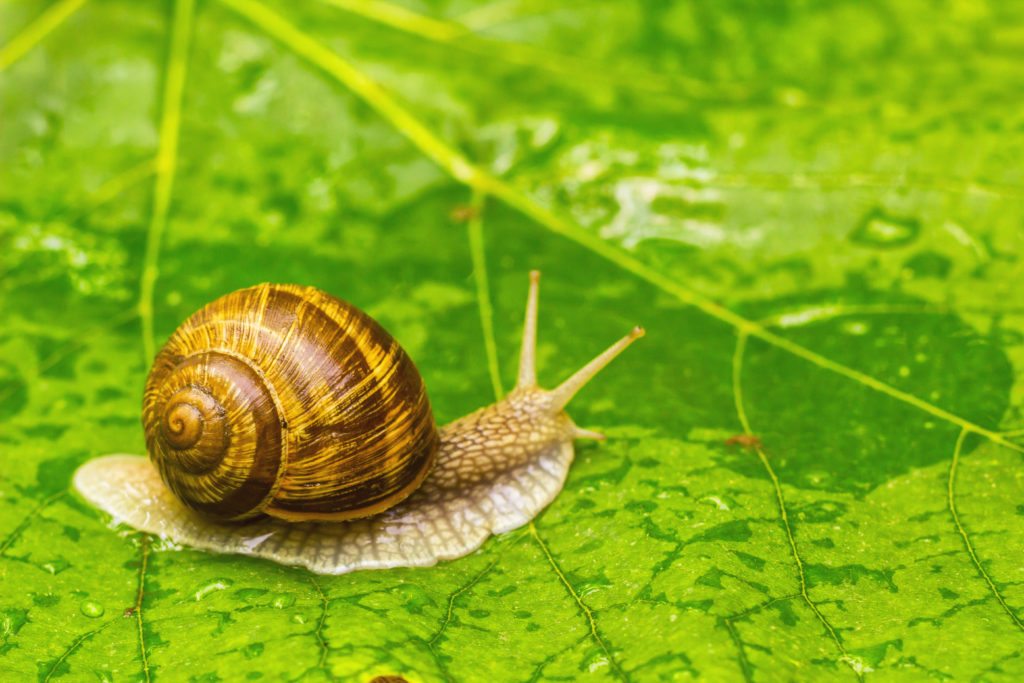
“Safe” House for Ducks
Another nice aspect of a sizeable duck pond is that it has room for a floating (or stilted) duck house. The benefit of sticking a duck house, or even just a floating island, in the middle of the pond rather than on the edge is that it helps the birds evade would-be predators at night. And, in doing so, there is no need to fret over locking gates and mending fences. The downside to a floating duck house, however, is harvesting the eggs from it. It might pay to plan some kind of way of pulling the house/island to shore for quick egg retrieval. Unfortunately, some predators, like racoons and minks, are known to swim for their prey.
Backyard Feature
Though permaculture designs often revolve around practical functions, don’t forget that recreation and simple pleasure (for you and the ducks) is a valid function. Ponds are just a beautiful feature for backyards so it’s logical to put the duck pond somewhere it can be enjoyed by people and critters alike. Adjoined to a duck pond could be a bench or small patio where an evening cocktail, conversation, and some idle time makes the pond as enjoyable for humans as it is for the ducks.
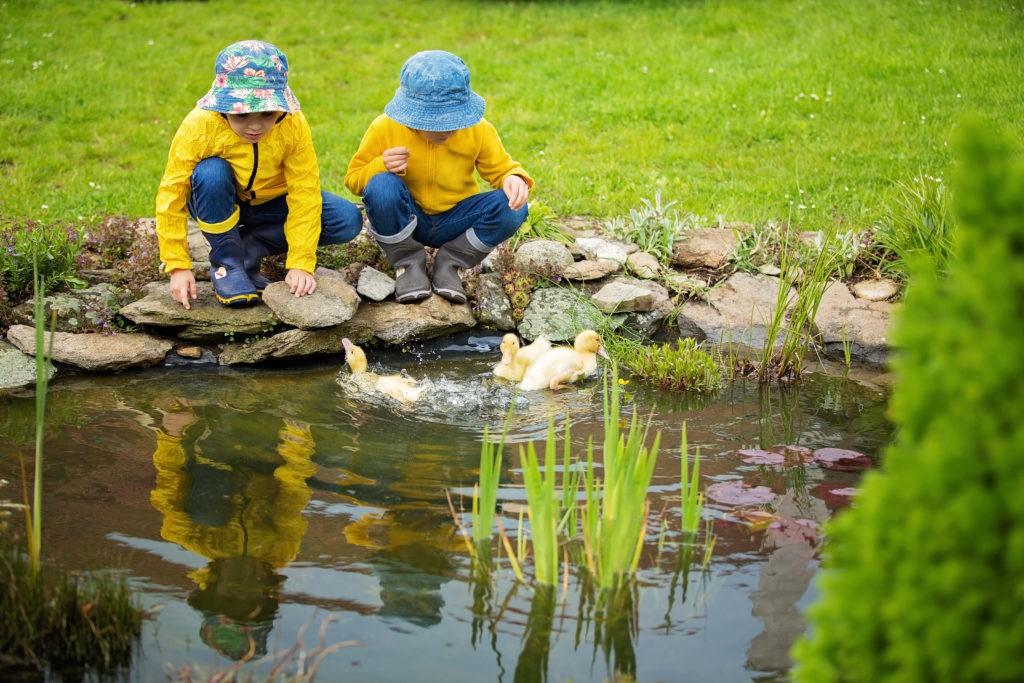
Duck ponds, or koi ponds or any ponds, have the potential to be so much more than just a hole full of water. For those of us looking to live efficiently and sustainably, we can make the most of our designs and desires when we explore the many ways they might function. In the end, we benefit, as does the world around us. The ducks will be none the wiser.
Jonathon Engels is a traveler, writer, and vegan gardener. Born and raised in Louisiana, he’s lived as an expat for over a decade, worked in nearly a dozen countries, and visited dozens of others in between. His interests include permaculture, cooking, and music. More of his work can be found at Jonathon Engels: A Life About.













1 Comment
Loved your article on getting the most out of your duck pond! Right now I have small trough pond for my ducks will someday have a larger pond ! Thanks for the tips.